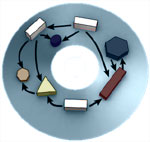Database
| Relational databases (RDBMS) have established themselves undisputedly to this day for the storage of data of business management origin (e.g. customer orders, supplier master data, financial accounting entries, etc.). Their data is organised in fixed table formats, whereby entire columns of these tables can be referenced among each other. In 1970, E.F.Codd published the theoretical basis for its relational model in the USA.
Each row of a table (a data set) can be seen as a single punched card or as a row of an Excel spreadsheet. The design of stable data structures is particularly aimed at avoiding redundant data, as well as at reducing the maintenance effort of user programs (transfer to the third normal form). | According to Rebecca Wirfs-Brock and her CRC method (Classes, Collaborations, Responsibilities), an object-oriented design is more about modelling data entities (Classes) according to their properties or methods (Responsibilities) in addition to their connections (Collaborations) to other classes (corresponds to the relations in a relational model). The complexity of a class usually exceeds that of a relational data entity, so it is obvious to use an object-oriented database for its storage.
| The business objects of ClassiX® are thus also modelled as containers, each of which can contain any additional information and relationships to other (individual) business objects. This increases the flexibility of the model and the application. On the other hand, however, this results in a very complex and company-specific network of interrelated objects, which is very close to the representation of the real information structure in a company. The system knows the application module for each object selected here, and the respective editing window is opened via the context menu.
|

